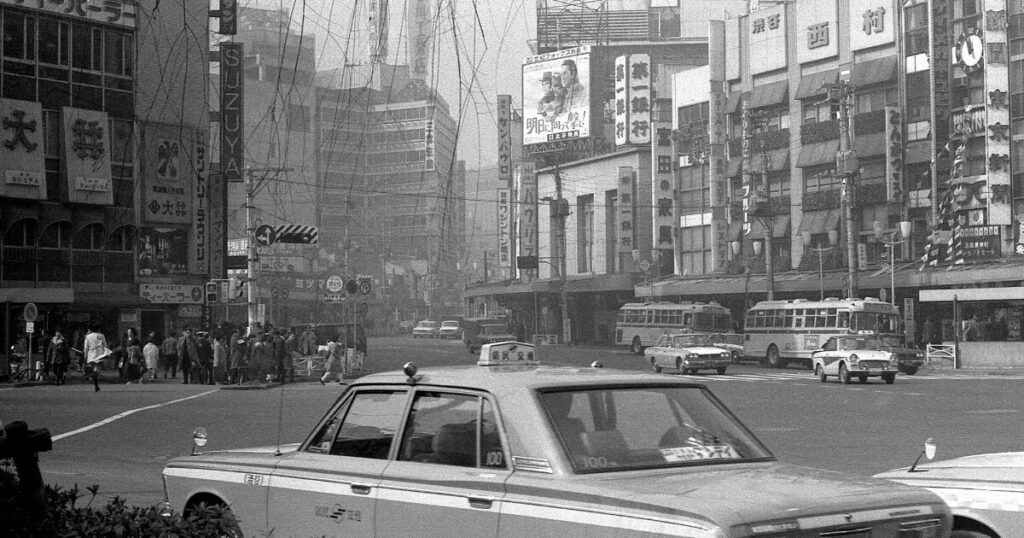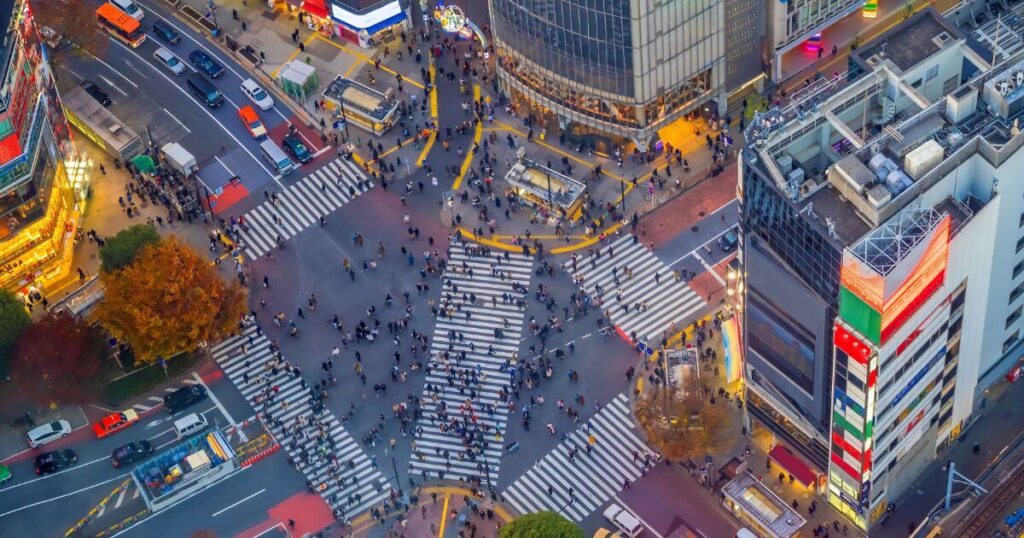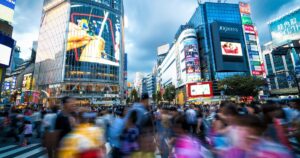Shibuya Scramble Crossing- The Ultimate Guide for Tourists in Tokyo

One of the world’s busiest pedestrian intersections, Shibuya Scramble Crossing is an iconic symbol of Tokyo’s vibrant urban energy. Located just outside Shibuya Station in central Tokyo, this famous crossroads stops vehicular traffic from all directions at once, allowing pedestrians to surge into the intersection from every side.
At peak times it’s a scene of organized chaos. Often compared to New York’s Times Square for its dazzling neon signage and massive crowds. For many visitors, braving the “scramble” is a must-do Tokyo experience, whether to feel the thrill of crossing amid thousands of people or to capture the perfect time-lapse from above.
Shibuya Crossing at night, a spectacular sea of people and lights. Bright billboards and giant video screens overlook the intersection, contributing to its Times Square-like ambience. Every two minutes or so, the traffic lights turn red in all directions, and a wave of hundreds pedestrians floods the crossing simultaneously.
This all-direction pedestrian phase known as a “scramble” crossing creates a photogenic blur of motion that has come to epitomize Tokyo’s high-energy street life.
History and Cultural Significance

Shibuya Scramble Crossing’s story began in the early 1970s, when the intersection was redesigned as an all-way pedestrian crossing to accommodate Shibuya’s growing crowds.
The scramble crossing officially began operation in 1973, making Shibuya one of the first places in Japan to adopt this innovative traffic concept.
As Shibuya developed into a major commercial and entertainment district through the late 20th century, its central crossing grew into a beloved local landmark.
Today, Shibuya Crossing is Japan’s largest and best-known scramble crossing, and it has become a symbol of Tokyo recognized worldwide.
When all traffic stops and pedestrians surge across in every direction – diagonally, vertically, and horizontally – the intersection exemplifies the city’s remarkable blend of chaos and coordination. It’s often hailed as the busiest pedestrian crossing in the world, with observers noting that there is almost no lull in foot traffic even late at night.
A 2014 survey recorded about 260,000 people crossing here on an average weekday, swelling to 390,000 on weekend days. On the very busiest days, as many as half a million pedestrians may traverse the intersection.
In a single two-minute traffic cycle, up to 3,000 people can cross at once during rush hour enough to fill a stadium in moments.
The crossing’s immense scale has even been highlighted on the world stage: for example, footage of Shibuya Crossing was featured in the 2016 Olympic closing ceremony as an emblem of modern Tokyo.
Shibuya Crossing at a Glance (Key Facts)
To quickly recap the essentials of Shibuya Scramble Crossing, here is a summary of key facts and figures.
| Fact | Detail |
|---|---|
| Location | Shibuya district, Tokyo – directly outside Shibuya Station’s Hachikō Exit |
| Inaugurated as Scramble | 1973 (pedestrian scramble crossing introduced) |
| Pedestrians per day | ~260,000 on an average weekday ~390,000 on a weekend day |
| Pedestrians per cycle | Up to 2,500–3,000 people every signal change |
| Nickname | “Shibuya Scramble” or scramble kōsaten |
| Notable landmark | Hachikō Statue, a famous meeting spot next to the crossing |
| In Pop Culture | Featured in films (e.g. Lost in Translation) and countless travel photos/videos |
Visiting Shibuya Crossing

Shibuya Crossing is free to visit and open 24/7, and no trip to Tokyo is complete without experiencing it.
That said, a bit of planning can help you get the best out of your visit. Below, we provide practical tips on how to get there, the ideal times to go, where to enjoy the best views, and how to navigate the crossing politely and safely.

Best Times to Visit the Crossing

What’s the best time to experience Shibuya Crossing?
It depends on whether you want to see the maximum crowd or avoid it. The crossing is active throughout the day and well into the night.
Here are some timing tips!
Late Night (10 PM and later)
Shibuya stays lively late into the night, thanks to clubs and bars in the area. Up until the last train (around 12:30 AM), you’ll still see significant crowds crossing – especially on weekends. After 1 AM the foot traffic finally dies down. Late at night (say 11 PM), you can experience the scramble with fewer pedestrians than the evening peak, but it’s never truly deserted.
The upside is you can often snag a spot at the scramble’s edges or on the overpass to take night photos without much jostling.
Evenings (Dusk to Night)
If your goal is to witness the full Shibuya Scramble spectacle, early evening to nighttime is ideal. Around 5:00 PM–9:00 PM the crossing is at its most packed on weekdays, and even later on Friday and Saturday nights. After sunset, the neon signs and giant screens light up, making the atmosphere especially electric and photogenic.
This is prime time for that classic Shibuya Crossing experience – you’ll see waves of people crossing in every direction with each light change. On weekends, midday and afternoons can also be extremely crowded.
Midday/Afternoon
Daytime is also busy, but slightly less so than rush-hour evening. Lunchtime (around 12:00–1:00 PM) sees a spike in foot traffic as local workers head out to eat, but mid-afternoon can be a bit lighter.
Daylight is great for capturing clear photos of the surrounding billboards and the scramble in action.
Morning (Before 9 AM)
In the morning, Shibuya Crossing is bustling with commuters from about 7:30–9:00 AM on weekdays. This is an interesting time to watch Tokyoites on their way to work.
If you’re up early, you’ll see a high volume of suited professionals and students efficiently making their way across. After the peak commute, late morning is relatively calmer on weekdays.
Early Morning (Sunrise hours)
Want to see Shibuya Crossing nearly empty? Go at dawn. Between the last trains around midnight and the first trains around 5:00 AM, the area quiets down significantly.
By 5:30–6:00 AM, you might catch the crossing with only a handful of people – a surreal contrast to the daytime crush (and a great chance for rare photos of the empty intersection).
This window doesn’t last long, though, as the city starts waking up soon after. If you’re jet-lagged or an early riser, a very early visit can be magical.
Shibuya Scramble Crossing is MUST-See Spot!!

Shibuya Scramble Crossing encapsulates the dynamic spirit of Tokyo. It’s one of those rare places where you can truly feel the city’s pulse – the constant movement, the blend of locals and travelers, the towering signs and sounds.
By following this guide, you’ll be well-prepared to enjoy Shibuya Crossing to the fullest, armed with knowledge of its background, the best viewpoints, and surrounding gems to explore.
Whether you visit for a quick photo-op or linger for hours amid the urban rush, Shibuya Crossing is sure to leave an indelible impression.
